How to Make Authentic German Rouladen
I will show you how easy it is to make delicious authentic German Rouladen, the ultimate comfort food, perfect for the fall and winter season.
If you visit a traditional restaurant in Germany, you will notice that German Rouladen are one of their most popular dishes.
I remember them from my childhood when my mom would make them fairly often. In fact, in those days, we would eat the biggest meal for lunch, not for dinner. They still are a staple in many German families.
Ultimately, this recipe is very flexible. You can use my recipe as a launching pad to try something different or just play with the ratios. It is perfect both for special occasions as well as for every day!
This post contains affiliate links, which means I make a small commission at no extra cost to you. You can read my full disclosure.
What are German Rouladen?
This traditional German dish are essentially beef slices filled and rolled up thin slices of meat that are braised with vegetables until tender. They are ideal for less expensive cuts of meat. Traditionally, Rouladen are made from beef, with the filling consisting of bacon, onions, and pickles. Braised for a long time with vegetables they literally swim in a flavorful, rich gravy.
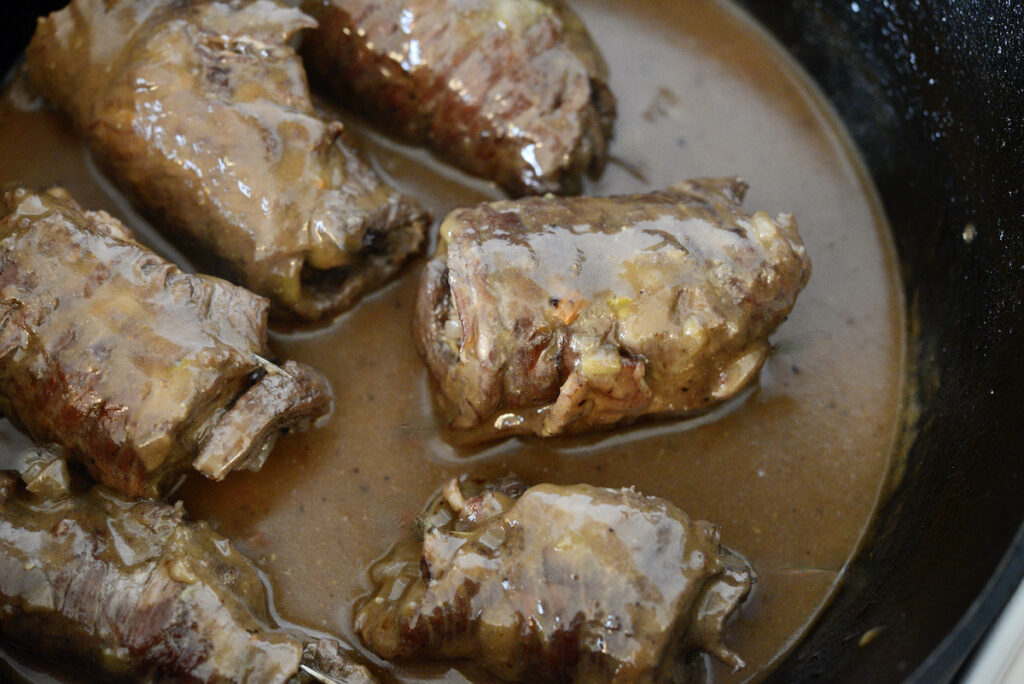
Why you’ll love these traditional German beef Rouladen
This recipe makes very traditional, authentic German Rouladen. It is absolutely delicious as it is with the flavor coming from browned meat, the vegetables, and a little red wine.
Even though I am given you exact measurements, you don’t have to stick to them. You can play with the amounts: don’t like mustard? Use less. Do you love vegetables? Add more or even double the amount. You don’t have a cast iron Dutch oven? Use another vessel. You don’t have one of the ingredients? Substitute with something else.
Once you have made the recipe you will see how easy it will be to make variations of this classic Rouladen recipe.
And don’t be put off by the length or number of steps for this recipe. It may look a lot more complicated than it really is. I hope you’ll give it a try to see how easy it really is.
What type of meat to use for Rouladen?
One of the challenges of “translating” a recipe from Germany to the US is that butchers cut up the animal differently, hence the different cuts. While Germans use “Oberschale” and have thin slices of beef cut specifically for Rouladen, there are some other cuts you can use in the US. When buying your meat in US grocery stores, you can ask for flank steak or fajita meat. If the pieces are very thick, I like to cut them horizontally (be careful when you do!). Then I often pound these slices to make them evenly thick.
Alternatively, you can use top-round beef. You can either cut it into thin slices yourself or ask your butcher to do that for you.
Sometimes, you can find fajita meat that has the right thickness and size.
Ideally, you want the slices of meat to be 3/8th of an inch or thinner. Again, you can always use a meat tenderizer to make them thinner.
While beef is the most popular meat for German Rouladen, people have also used pork or venison. You can even use chicken, although you won’t get that deep beef flavor that is so distinct for Rouladen.
Ingredients for German Rouladen
These are the ingredients for the classic German Rouladen recipe:
- meat: as I said above, I prefer beef but you can use pork, venison, or chicken. Whatever you use, make sure to cut it in long thin slices about 6″ wide and 10″ long (I don’t get so specific with my Rouladen … ).
- mustard: Dijon mustard is very similar to German mustard and often the easiest to find here in the US. You will spread this on the slices of meat. Feel free to use brown mustard or whole-grain mustard.
- bacon: I feel that bacon is essential for these authentic German Rouladen since it gives them extra flavor with its fat and smokiness. But you can get creative with other slices of ham.
- pickles: this is another essential. You can often find a German brand of pickles or cornichons. I prefer those since they don’t have a sweet taste.
- onion: thin slices of onions are the final ingredient for your German beef Rouladen
Ingredients for the sauce:
- red wine: I really like to add this since it gives the Rouladen their authentic taste. If you’re worried about the alcohol, just know that it all evaporates during the cooking. But you can always leave it out and use more bouillon/stock.
- bouillon/stock: either one works fine here. The amount depends a bit on the size of your dutch oven and the quantity of your Rouladen. Ideally, you want them covered but at least half.
- chopped carrots, celery, and leeks: these vegetables will flavor your sauce. In Germany, you can actually buy them bundled together for making soups or stocks. You can substitute onions for the leeks. If you can find root celery, your sauce will have an even deeper earthy flavor.
- bay leaf: I always like to add that to my stews and soups.
- tomato paste: this lends a nice acidity and good color to your sauce. Pro tip: since we only need about 2-3 tablespoons of tomato paste here, I like to freeze the rest in tablespoon-size chunks for other recipes. Alternatively, you could use fresh or canned tomatoes.
Useful tools and equipment
There are two types of “equipment” you will need to make German Rouladen:
- a cooking vessel: I love using my cast iron Dutch oven since it makes for very even heat distribution. With that, you can braise the Rouladen on the stovetop or in the oven. However, you can use a regular stainless steel pot or enameled cast iron pot. When in a hurry, I like using my old-fashioned pressure cooker (my mom always used that). A crock pot or instant pot will be another but more modern choice.
- something to keep the Rouladen together: since you will be rolling up the filled slices of meat, they would fall apart during the cooking process. Therefore, you need to make sure they stay rolled up. My preference is poultry lacers. A lot of people like to use cooking twine. While it takes a bit longer to tie up the Rouladen, it does a good job of keeping the stuffing in. If you don’t have either, you can also use wooden toothpicks or skewers.
If you purchase a top round or very thick flank steaks and don’t have a butcher who can do that for you, you might need to slice your meat:
- a good meat slicer: you want to use the sharpest knife you have. I rummaged through my husband’s knife drawer and always like to use his nice meat slicer.
How to make German Rouladen
Prep the vegetables:
First, I like to prep the vegetables by dicing the leeks, carrots, and celery. I will put them in bowls and set them aside.
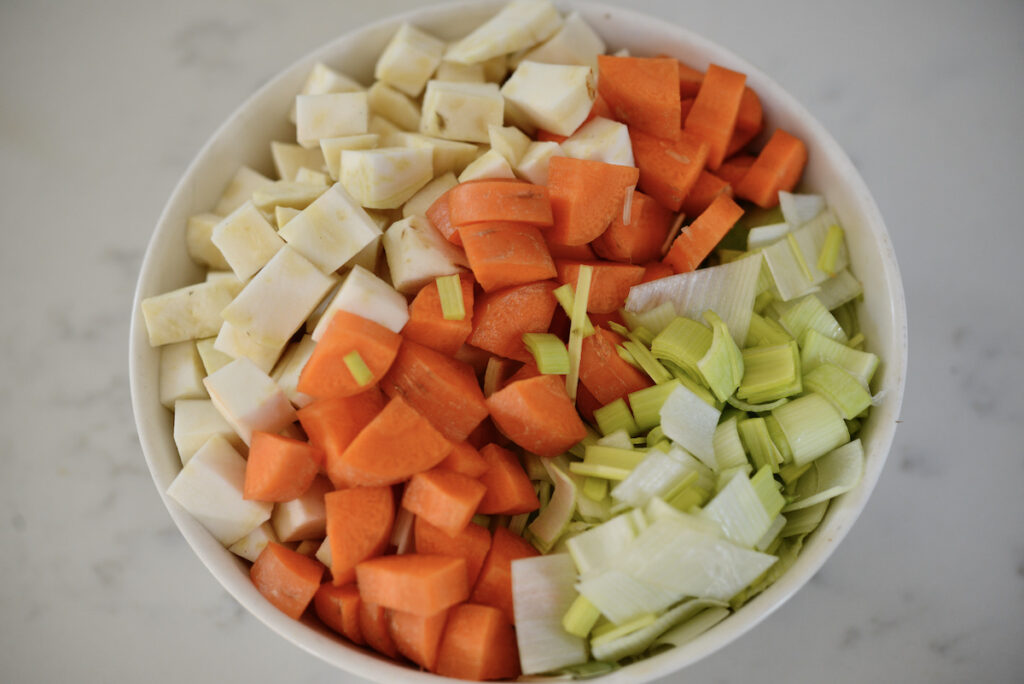
Prepare the meat:
Depending on what kind of cut of meat I am using, I might have to slice it in half horizontally. I do that very carefully so as not to cut myself with a very sharp knife. You might also be able to ask your butchers to do that with you.
Next, I like to pound the meat with a meat mallet to make the slices thinner and even.
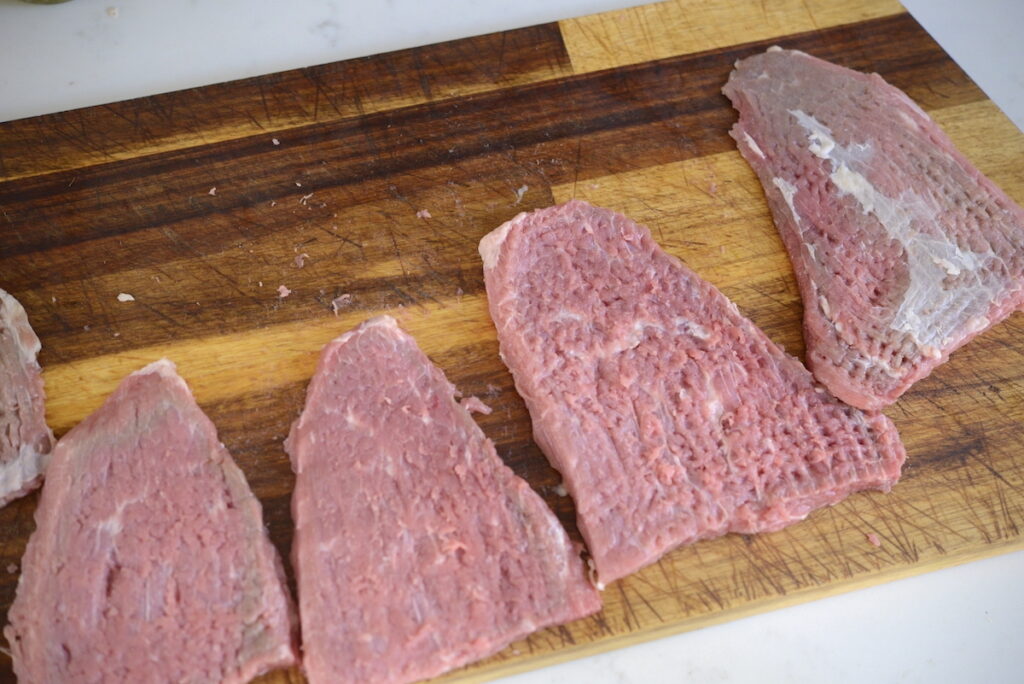
Fill the Rouladen:
Ideally, your Rouladen are about 6″ wide and 10″ long but do the best you can with what you have. I don’t worry about the size as much but I might also get smaller and bigger Rouladen in one batch.
I lay them out on a big cutting board. First, I spread 1-2 teaspoons of mustard on each slice of beef.
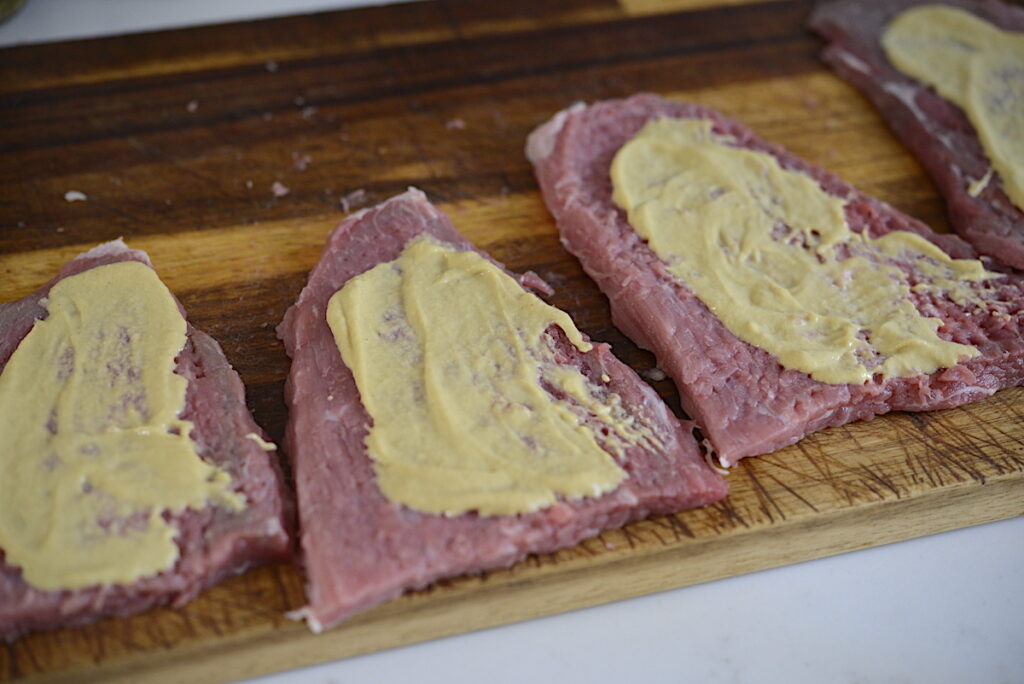
Then I place one slice of bacon on each slice of meat. Next, I place cut gherkins and some onion slices at one end of each piece.
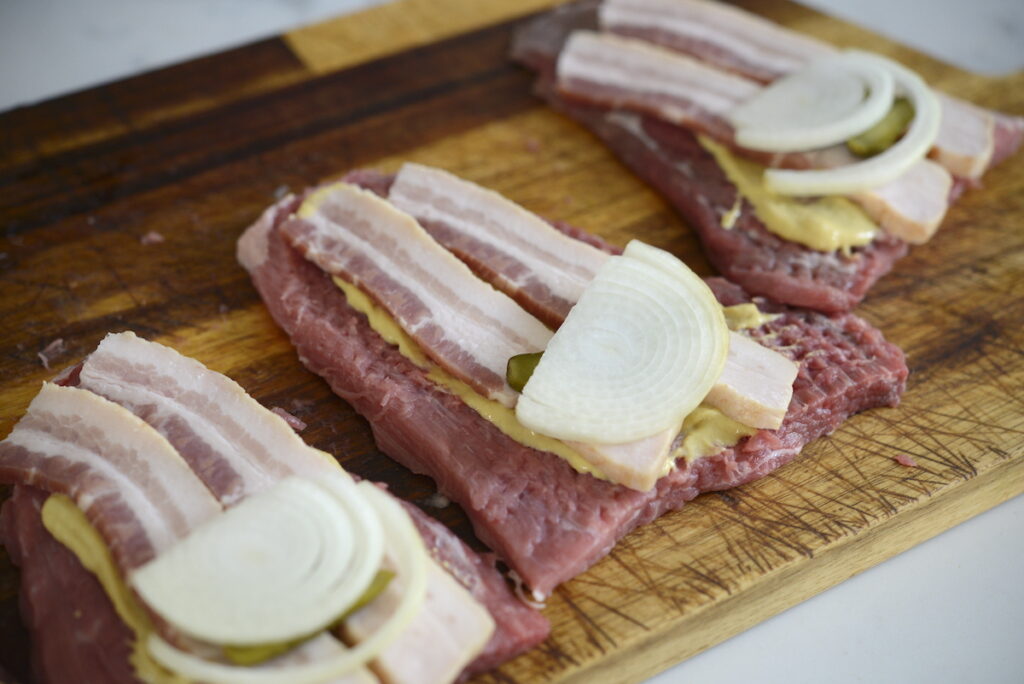
Roll the Rouladen:
Starting with the end that has the onions and pickles, I tightly roll up each slice of meat. When I am done, I am using poultry lacers to secure the rolls in place. Alternatively, you can use cooking twine or wooden toothpicks or skewers.
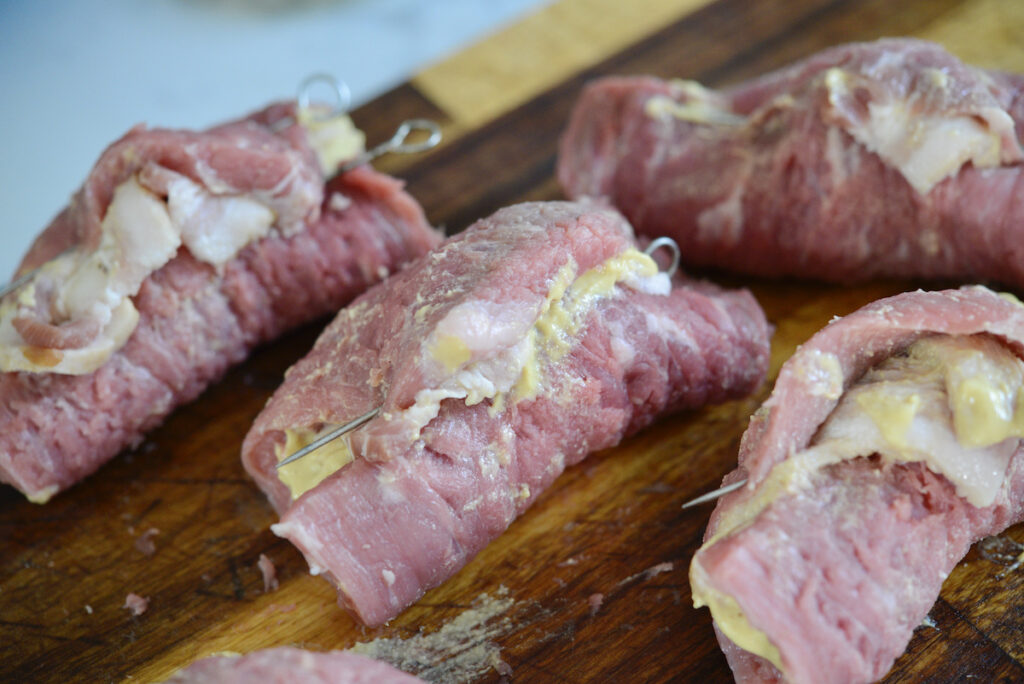
Brown the meat:
For best results, I preheat a large Dutch oven over medium-high heat. Then I add the oil and the Rouladen. The goal is to brown them. With kitchen tongs, I turn them every so often. Once they’re nice and brown, I remove them from the Dutch oven and place them on a plate.
Sautee the vegetables:
To the same Dutch oven, I add all the vegetables and sautee them for about 5 minutes while stirring them occasionally.
Make the braising liquid:
To the vegetables, I add about 1 cup of red wine, scraping the browned bits off the bottom of the pot. I like to cook this down a bit. Then I add the Rouladen back to the dutch oven, add another good cup of stock or bouillon or enough to cover the Rouladen at least by half.
Braise the Rouladen:
I put a lid on the Dutch oven and place it in the oven to braise the Rouladen at 320˚F for about 90 minutes. Then I like to check for doneness. If the meat is very tender, the Rouladen are done. If not, I return them to the oven for a bit longer.
Make the sauce and final touches:
When the Rouladen are very tender, I remove them from the Dutch oven with kitchen tongs and place them on a plate. Then I strain the vegetables through a mesh colander and collect the liquid in another bowl. You can either serve the reserved vegetables and eat them with your German Rouladen or use them for something else.
To thicken the sauce, I add about 1-2 tablespoons of butter and 1-2 tablespoons of flour to a skillet or the Dutch oven. I melt the butter over medium heat, stir it well with the flour, and then add the reserved liquid and 1-2 tablespoons of tomato paste. Then I bring everything to a boil and cook it over low heat to create a thick sauce. If it ends up too thick, you can always add some more red wine or bouillon. If the sauce is not thick enough, you can add more flour or cornstarch. Lastly, I season the sauce well with a little salt and fresh-ground black pepper.
I put the Rouladen back into the Dutch oven into the sauce and coat them evenly with sauce. Should they have cooled down, I gently reheat them in the sauce.
How to serve German Rouladen
While you can eat this classic German dish with anything you like, there are some very traditional sides.
Braised red cabbage is the classic accompaniment for Rouladen. Feel free to serve your Rouladen with any vegetable you like, though.
Then, you can serve these beef rolls with boiled potatoes or German potato dumplings. You will often see them being served with Spätzle as well (they are essentially tiny German dumplings).
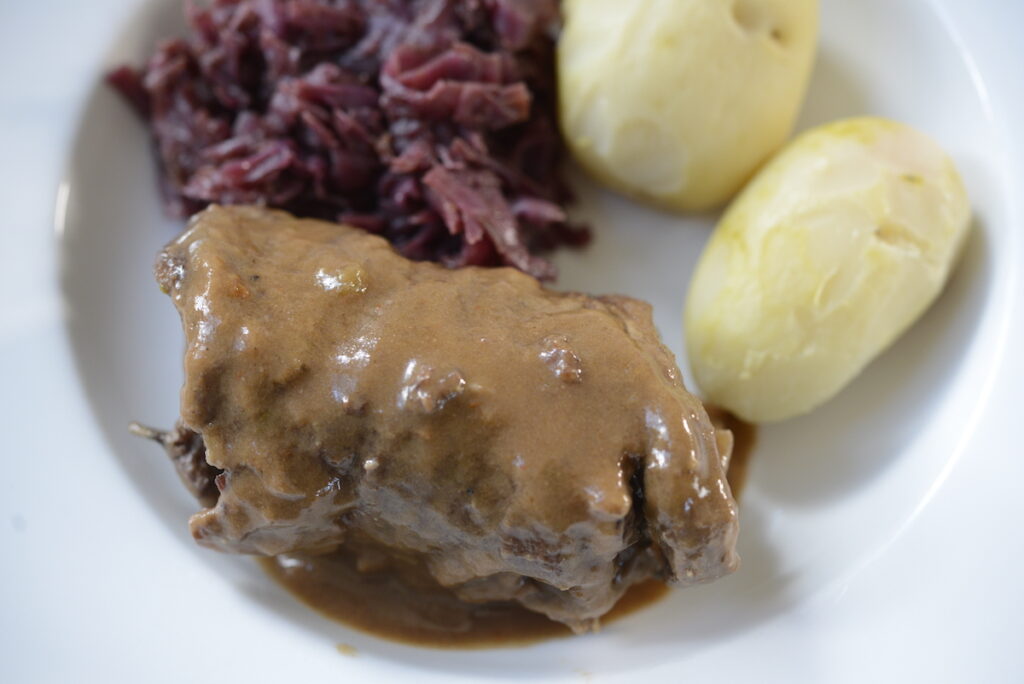
Different cooking options for German Rouladen
The key to this dish is to braise it until the meat is very tender. This will depend on how thick and even your slices of meat are and what type of meat you are using. You can expect to cook your German Rouladen for at least 90 minutes or about 25 minutes in a pressure cooker.
I personally love making them in my cast iron Dutch oven in my oven since I think it provides the evenest heat.
If you own a crockpot or slow cooker, you can perfectly use that, too. And if you own an instant pot, that would be a great choice, too. Since I don’t own one as of the time of writing this post, I am not sure what setting you would use.
Thermomix also has a setting to make perfect Rouladen.
Authentic German Rouladen
Equipment
- Meat mallet
- Poultry lacers, wooden toothpicks, skewers, or cooking twine
- Cast iron dutch oven, enamel dutch oven, pressure cooker, crockpot, or instant pot
Ingredients
- 1 ½ pounds flank steak or beef top round
- 8 slices bacon
- 8 tsp Dijon mustard
- 8 whole gherkins, cut in half lenghtwise
- 4 TBSP onion slices
- 3-5 TBSP heat-resistant oil such as avocado, lard, or tallow
- 1 large carrot
- 2-3 stalks celery
- 1 small leek
- 1 cup red wine
- 1 ⅓ cups bouillon or stock
- 1 whole bay leaf
- 1-2 TBSP butter
- 1-2 TBSP AP flour
- 2-3 TBSP tomato paste
- salt & pepper to taste
Instructions
- Dice the carrots, celery, and leeks. Set aside.
- Depending on thickness cut meat horizontally to about ⅜" thickness. You can use a meat mallet to pound the slices of meat to a more even thickness.
- Lay the meat slices on a large cutting board. Spread 1-2 tsp of mustard on each slice of meat.
- Place one piece of bacon on each slice of meat.
- At one end of the meat slices, place some gherkins and onion slices.
- Starting from the end with the pickles and onions, tightly roll up the rouladen.
- Secure each roll with poultry lacers, toothpicks, skewers, or cooking twine.
- Preheat the oven to 320˚F.
- Heat the cast-iron skillet over medium-hot heat. Add a few tablespoons of heat-resistant oil.
- Carefully add the rouladen, possibly in batches, and sear to brown.
- When the rouladen are nice and brown on most sides, transfer from the dutch oven to a plate.
- Add the diced vegetables to the dutch oven and sautee for about 5 mins, stirring occasionally.
- Add the red wine, scraping the browned bits off the bottom of the dutch oven.
- Add the rouladen back to the dutch oven. Top with enough bouillon or stock to cover the rouladen at least by half. Add the bay leaf.
- Place a lid on the dutch oven and place it in the oven for about 90 mins.
- Check the meat for tenderness. If it is not very tender, return the rouladen back to the oven for another 15-25 mins.
- When the rouladen are very tender, transfer them to a plate.
- Strain the vegetables and save the liquid. You may also save the vegetables or use for something else (they are actually very aromatic).
- Melt the butter in the dutch oven over medium-low heat, add the flour, and stir to combine. Add all of the reserved liquid. Using a metal whisk, bring to a boil, stirring constantly.
- If the sauce is too thick, add more red wine or bouillon. If it is too runny, add more flour or cornstarch.
- Whisk in tomato paste to taste.
- Add the rouladen back to the dutch oven, coating them evenly with sauce.
- Serve immediately with braised red cabbage and boiled potatoes, potato dumplings, or Spätzle.
Notes
Nutrition
Shop this Post:
Poultry Lacers & Cooking Twine
Other German Recipes you might enjoy:
How to make German Potato Salad
Let me know if you have comments or questions!
Pin For Later:
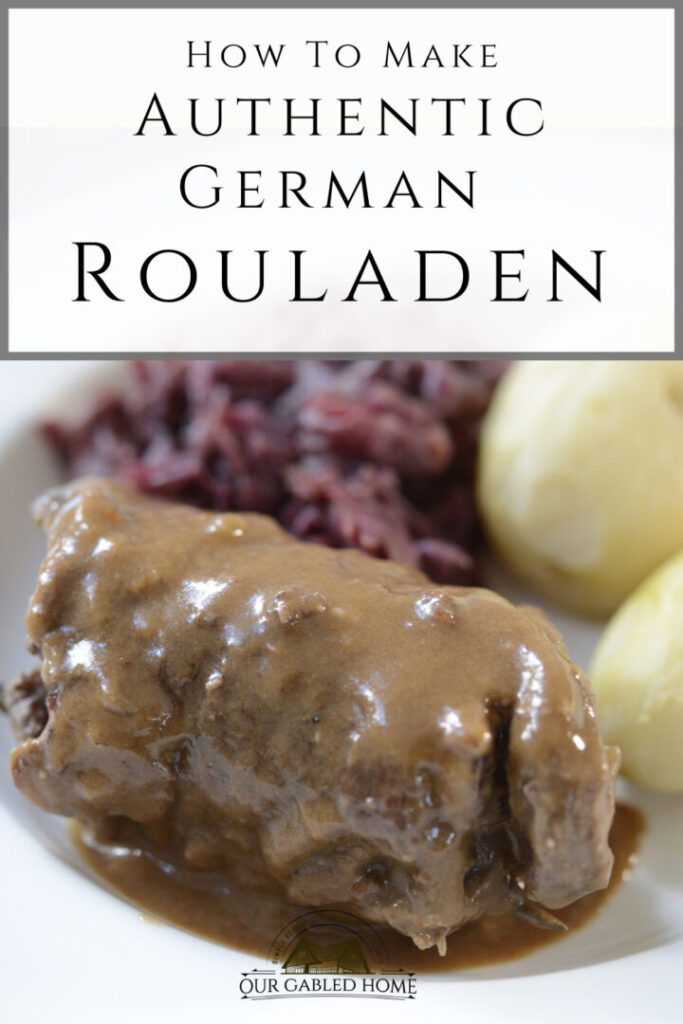


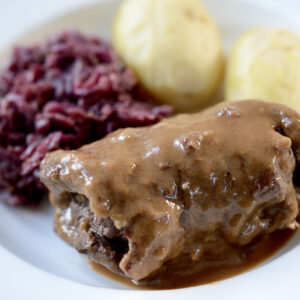
Hi, Anya.
Your rouladen recipe is very similar to ours. I was born in Germany, with parents from Silesia. Currently live in Silicon Valley, not all that for (comparatively) from you.
This is probably going to sound brain-dead, but the idea of slicing the onions, rather than chopping them, is brilliant. I’ve been making rouladen for 35 years or so, and the one thing that has always infuriated me about the process is the fact that the browning process always resulted in the onions falling out and burning. I tend to make large batches, 20-30 at a time, so they have to be browned in batches, and didn’t want to fuss with cleaning/wiping out the pans in between batches. Messes up the fond, or I’m too lazy, not sure which. Actually, yes I do, and it’s not the fond part.
I learned to make them from my mother, and she always chopped. I’ll definitely try slicing them this year.
I found your site while searching for information about sourdough bread baking, and I like what I’m seeing here. On the downside, I’ve never baked bread, but I already want to buy one of the grain mills.
Thanks for all the work that you put into making the site as good as it is.
Regards,
Joachim
Thank you for sharing your version and I am glad you like sliced onions better! My father was born in Pomerania and yes, you are not too far from me ~ Anja
This is absolutely my favorite German dish. Whenever my whole family gets together, we’ll make Rouladen with Spätzle. Our recipe is virtually identical to yours, Anja!
One tip I’ll share for those who aren’t able to find thin enough cuts of meat & need to slice it at home: put it in the freezer for awhile first, not so long that it freezes hard, but long enough for it to start freezing & become a bit more firm. That makes slicing much easier.
The last time I made Rouladen here in Marin I used veal I got from a local vendor at the farmers’ market, which was marketed as “scallopini.” This veal is humanely raised, unlike most you’d find in the supermarket. It’s perfect for Rouladen or Schnitzel.
Thanks for sharing a dose of home!
Nice!! Great tip about freezing the meat before slicing (which I would have done if I had had more time …). I bet it was heavenly with veal! Thank you so much for sharing and commenting ~ Anja
This German Rouladen looks delicious, and I like how it can be adapted in different ways. I can’t wait to try it! Thank you for sharing!!
I’m so glad I saw this recipe! My husbands family is from Germany, maybe I can impress them by naming this 😊 thanks for sharing!
Oh, I bet you can get a lot of brownie points with this recipe 😉 ~ Anja
You have done it again! This roulade recipe is phenomenal. It’s easier to make than I originally thought. I cannot wait to make this again.
It really is so easy which you will see once you make it! Happy cooking ~ Anja
Wow looks delicious! Can’t wait to give this a try.
Thank you so much! Happy cooking ~ Anja